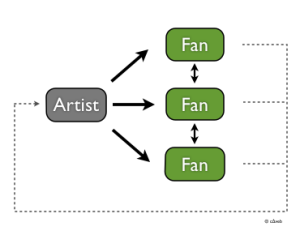 April 1, 2013
April 1, 2013 Fan Interaction: Why successful EDM Artists and Jam Bands are ahead of the game.
The biggest thing in common between these types of acts, aside from the volume of drugs consumed, is the level of mastery in connecting fans with fans.
Let’s take a quick look at three different types of fan interaction:
Artist >> Fan
This is how you make and keep fans – usually. They see you play a show, or they find your record somewhere and connect with it; they decide that it’s had a profound impact on them, changed their level of enjoyment/happiness, understanding, perspective, or life, and the relationship begins. They come back, follow you online, sign up for your mailing list, buy merch, and more as the relationship grows.
Fan >> Fan
A satisfying interaction - this is two people experiencing something they’re both extremely passionate about; listening to records, dancing, singing with another fan; conversations about the artist both in-person and online (fan sites, groups, forums, etc.). This is incredibly enjoyable for fans when it happens; they can exchange thoughts, opinions, live recordings, talk about best shows, new tours, records, and much more. Social objects - such as t-shirts, merchandise, vinyl, etc. - help to ignite fan-to-fan interactions as well.
Artist >> Fan >> Fan
The less understood - a combination of the two aforementioned types of interaction. This is going to a concert and experiencing not only the artist, but the fans and other like-minded members of the tribe as well – all having a great time. People talking, communicating, dancing - oftentimes costumes, beachballs, eccentric outfits, etc. - it’s a party and when you go, YOU are helping to create that experience, YOU become a part of something much bigger than you were before arriving for that show. And in both improvisational-laden styles, the fans (especially fans moving other fans) are an absolutely integral part of the live event!
Artists feed off this energy in the moment!
And the fans do too!
When Artist >> Fan >> Fan exists, you’ve successfully begun the formation of a Tribe/Scene/Culture.
This is what successful electronic artists and Jam bands have mastered. It’s about connecting people and having a great f*^#ing time! People don’t go to these shows to simply see and hear the artist, they go to be a part of something much bigger… and to have a great f*^#ing time!
And yes production has a lot to do with that now, but your production, lights, etc. can only be so effective - most people want to connect with others! They want to have a great f*^#ing time with other people and know that everyone else, including the artist, is having a great f*^#ing time! It’s part of the experience!
These artists’ fans are small reflections of the artist’s themselves. They live similar lifestyles, share similar beliefs, philosophies, likes and dislikes, etc.
They all know that going to a live show is about having a really f*^#king great time.
They all know that the music has to be great, but that there is more to it.
Your fans are a part of the culture.
Your fans are a part of you.
Are you in it for the experience?
c∆ve-b ||
 EDM,
EDM,  Electronic,
Electronic,  Live Music,
Live Music,  Music Industry,
Music Industry,  Music Management,
Music Management,  Music Strategy,
Music Strategy,  festivals,
festivals,  music business,
music business,  music festivals,
music festivals,  music marketing,
music marketing,  production | tagged
production | tagged  Electronic,
Electronic,  Music Industry,
Music Industry,  artist interaction,
artist interaction,  caveb,
caveb,  c∆veb,
c∆veb,  edm,
edm,  fan interaction,
fan interaction,  festivals,
festivals,  jam bands,
jam bands,  music business,
music business,  music strategy,
music strategy,  what music industry
what music industry 






Reader Comments (2)
nice article. i also feel that edm and jambands artists embrace their fans eagerness towards the p2p file sharing options available theses days as well as giving out their singles, live shows, youtubes, etc. for free. people always like the self-satisfaction of being the person that introduced "said person" to the new cool thing. i dont see that feeling going away any time soon either...
unless people just start getting lame
+1 breaking down the barriers between artists and fans